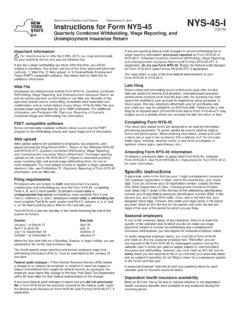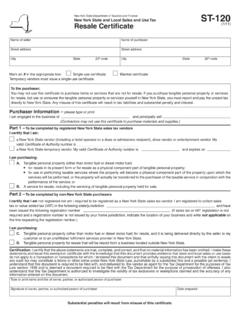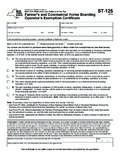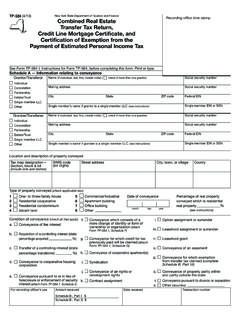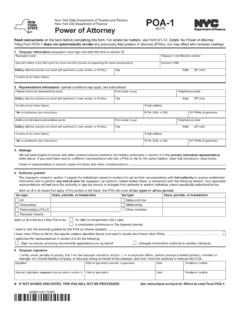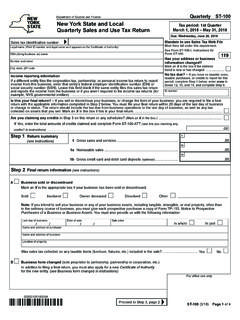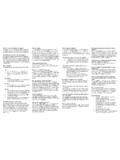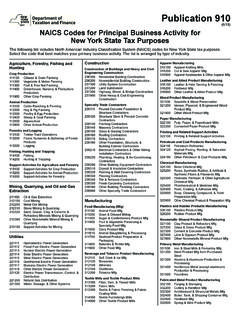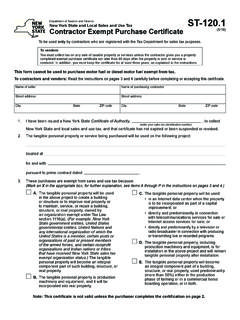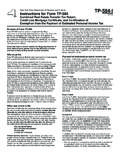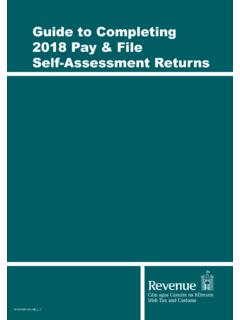Transcription of Page 22 - The New York City enhanced real property tax ...
1 Important As a result of recent law and procedural changes, the following information contained in this publication is out of date: Page 22 - The New York City enhanced real property tax credit has been extended and is available for tax years 2014 through 2019. Page 27 - Filing options- The department no longer offers the Web File option through the department's website. However, you may still be eligible for free E-file. Page 28 - Taxpayers may no longer choose to receive their refund by debit card. The available options for receiving a refund are direct deposit or paper check. Page 34 - Suspension of STAR eligibility for taxpayers with past due state tax liabilities only applied for STAR.
2 Exemption through the 2015-2016 school year. Publication 36 begins on page 2 below. Publication 36. General Information for Senior Citizens and Retired Persons Pub 36 (3/15). Note: A Publication is an informational document that addresses a particular topic of interest to taxpayers. Subsequent changes in the law or regulations, judicial decisions, Tax Appeals Tribunal decisions, or changes in department policies could affect the validity of the information contained in a publication. Publications are updated regularly and are accurate on the date issued. The information provided in this document does not cover every situation and is not intended to replace the law or change its meaning.
3 Publication 36 (3/15). Table of contents Page Introduction ..5. Resident status ..5. Nonresident ..7. Part-year resident ..7. Filing requirements ..7. Nonresident recipients of pension income ..9. New York State subtraction modifications ..11. Social security and equivalent railroad retirement benefits ..11. Railroad retirement benefits ..11. Pensions of New York State, local governments, and the federal government ..11. Pension and annuity income exclusion ..13. Long-term residential care deduction ..16. New York tax credits ..16. Child and dependent care credit ..16. Earned income credit (EIC) ..18. Real property tax credit ..18. Credit for purchase of an automated external defibrillator.
4 19. Long-term care insurance credit ..19. Nursing home assessment credit ..20. New York City school tax credit ..21. New York City enhanced real property tax credit ..22. Other taxes ..22. Metropolitan Commuter Transportation Mobility Tax (MCTMT) ..22. Sales or use When to Automatic six-month extension of time to file ..24. Automatic extension for death of a spouse ..25. Free tax return preparation assistance by volunteers ..25. Paid tax return preparers ..26. Registered tax preparer database ..26. Filing options ..27. Payment options ..27. Check or money order ..27. Electronic funds withdrawal ..27. Paying by credit card ..28. Overpayments, refunds, and collection of debts.
5 28. Direct deposit of refunds ..28. Debit card by mail ..28. Paper check by mail ..29. Estimated Collection of debts from your Publication 36 (3/15). Table of contents (continued) Page Estimated tax requirements ..30. Estimated income tax ..30. Estimated MCTMT ..31. Request withholding from an annuity or pension ..31. Privacy and confidentiality ..31. Third-party designee ..32. Power of attorney ..32. Consumer Bill of Rights Regarding Tax Preparers ..33. Requirement to provide contact information ..33. Exempt preparers ..33. New York City tax preparers ..34. New York State School Tax Relief (STAR) Program ..34. Suspension of STAR eligibility for taxpayers with past due state tax liabilities.
6 34. Publication 36 (3/15). Introduction This publication provides general tax information that may be of special interest to senior citizens and retired persons. It will help you determine if you need to file a New York State personal income tax return. As a senior citizen or a retired person filing a New York State income tax return, you may qualify for special income tax benefits that can reduce your tax liability. These benefits include subtraction modifications that will reduce your New York State adjusted gross income, and tax credits that may decrease your tax due or increase your refund. If you do not have to file a New York State income tax return, you may still be eligible to claim a refund of certain credits (see New York tax credits on page 16).
7 See the Need help? section on the back cover of this publication or visit the Tax Department Web site for information on how to get assistance. For federal income tax information, visit the Internal Revenue Service (IRS). Web site ( ) or call 1 800 829-1040. Resident status You need to determine if you are a resident, nonresident, or part-year resident before you can decide if you need to file a New York State return. To determine your resident status, you have to consider where your domicile was and where you maintained a permanent place of abode during the tax year. Domicile In general, your domicile is the place that you intend to have as your permanent home.
8 Your domicile is, in effect, where your permanent home is located. It is the place you intend to return to after being away (as on vacation abroad, business assignment, education leave, or military assignment). You can have only one domicile. Your New York domicile does not change until you can demonstrate that you have abandoned your New York domicile and established a new permanent domicile outside New York State. A change of domicile must be clear and convincing. Easily controlled factors such as where you vote, where your driver's license and registration are issued, or where your will is located are not primary factors in establishing domicile. To determine whether you have, in fact, changed your domicile, you should compare: the size, value, and nature of use of your first residence to the size, value, and nature of use of your newly acquired residence.
9 5. Publication 36 (3/15). your employment and/or business connections in both locations;. the amount of time spent in both locations;. the physical location of items that have significant sentimental value to you in both locations; and your close family ties in both locations. A change of domicile is clear and convincing only when your primary ties are clearly greater in the new location. When weighing your primary ties, keep in mind that some may weigh more heavily than others, depending upon your overall lifestyle. If required by the Tax Department, it is the taxpayer's responsibility to produce documentation showing the necessary intention to effect a change of domicile.
10 If you move to a new location but intend to stay there only for a limited amount of time (no matter how long), your domicile does not change. Permanent place of abode In general, a permanent place of abode is a residence (a building or structure where a person can live) that you permanently maintain, whether you own it or not, that is suitable for year-round use, and usually includes a residence your spouse owns or leases. Resident You are a New York State resident for income tax purposes if: Your domicile is not New York State but you maintain a permanent place of abode in New York State for more than 11 months of the year and spend 184 days or more (a part of a day is a day for this purpose).
